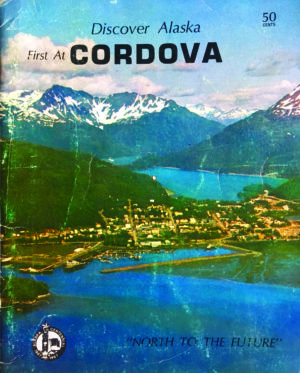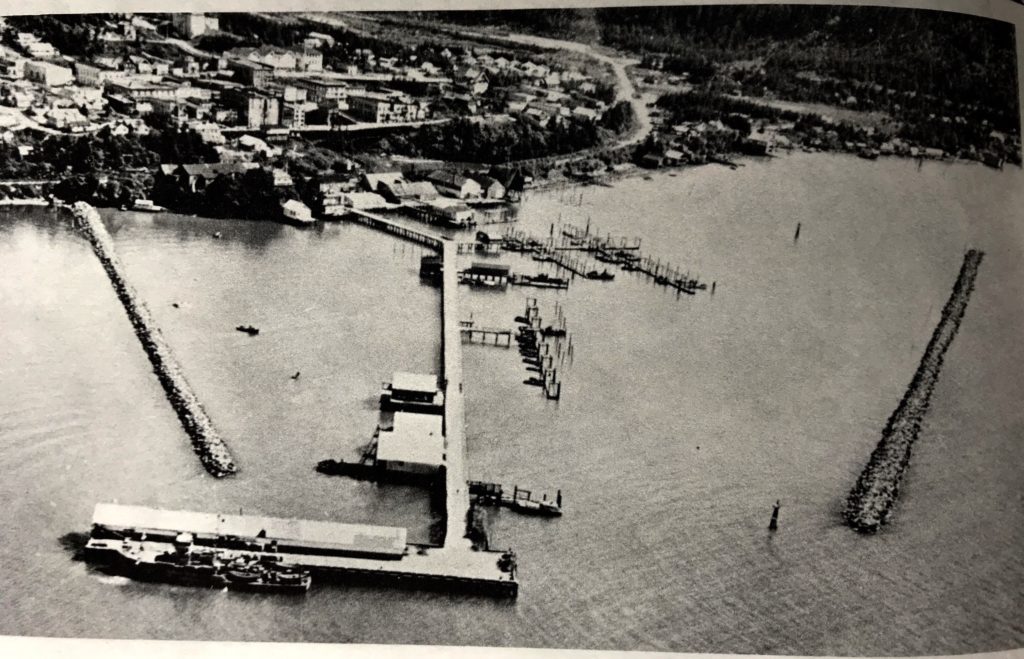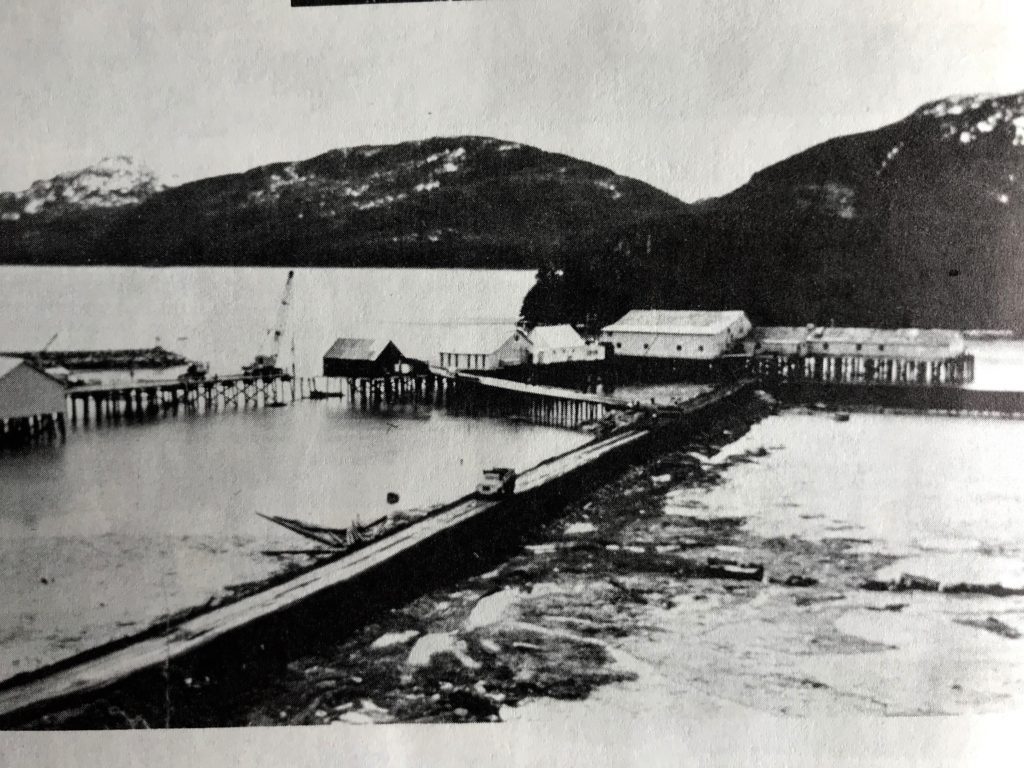
1967 was the 100th anniversary of the purchase of Alaska from Russia, and in recognition of that special year, the Cordova Chamber of Commerce published a 57-page booklet titled “Discover Alaska First at Cordova – A Guide to the Cordova Area.”
Replete with history and contemporary information, as well as advertisements by almost all of Cordova’s enterprises, the booklet provides a unique look at our city 54 years ago.
1967 happened to reflect very challenging times for Cordova. After all, in 1963, just four years earlier, the biggest fire in local history totally wiped out an entire block of Main Street. And a year later, it was the massive 9.2 Good Friday earthquake that shook much of Alaska, and particularly Prince William Sound, with its epicenter in College Fjord near Whittier.
The result here was a 7-foot uplift that literally drained the harbor and changed the geology of this region. Yet Cordovans responded with typical character and speed. Main Street was being rebuilt from the fire damage and an amazing transformation was taking place at the harbor that is almost overlooked today.
Much of what we take for granted as the Cordova harbor was a mud flat covered by tides prior to the ’64 earthquake, and the dock was an isolated finger that stretched out toward Spike Island, with small rock breakwaters on both sides.
Dredging was necessary to make the harbor deep enough for vessels. It involved a massive movement of material, and by amazing foresight, what resulted was the industrial landfill to the north, later to be followed by a similar expansion to the south. That new land now contains a major portion of Cordova’s fishing industry and related businesses.
One of the first to move into the “new digs” was none other than the Cordova Outboard Shop, which looks almost identical today as when it was rebuilt on slowly consolidating dredge materials.
In the Centennial booklet, the shop proudly advertised its new pre-engineered steel building, which in 1967 was just two years old. It was built on pilings sunk into the still-settling substrate. Caution was advised should one wander too far from its boundaries. Randy Bruce, a young outboard mechanic at the shop, recalled burying a truck up to its rims when mistakenly trying to drive around to the back of the building while moving freight.
The booklet contained countless fascinating tidbits of all sorts.
For example, at that time the Cordova Public Utilities operated a plant that was located on the lower end of Council Street. Their ad for “Water – Telephone – Power” featured a photo of a massive 1000-HP, 750-KW G engine that had an output of 12,000 KW of electricity per day, and the ability to operate continuously for 15 to 18 thousand hours between overhauls.

A pair of such machines was the key to Cordova’s electricity. Not mentioned was the fact that the engines came from WWII submarines, of all things. One wonders how many German or Japanese ships may have been victims of the power of these diesels before they ended up shore-bound in Cordova.
Not long ago, questions about the history of the building that now houses the Wells Fargo Bank circulated about on Facebook. The booklet contains an advertisement by R.R. Borer Insurance showing a photo of the inferno that engulfed the Lathrop Building back in 1951. At that time, it housed the community’s only theatre, a jewelry store, the Alaska Communications Service office, a museum and many apartments. The second half of Borer’s ad displays the gutted shell rebuilt into an “ultra-modern symbol of Cordova’s comeback from disaster and faith in the future” that we see today
Among the 60 ads contained in the booklet were some chucklers. Frank and Chris Theodore, who owned the Cordova House at that time, decided to proudly feature a three-piece band providing “Live Entertainment in the Cotto Room with ‘Discotheque Dancing.’” A closer examination revealed a trio of gals on drums, accordion, and bass fiddle. Evidently Scandinavian fishermen liked their own special brand of disco.
Also tucked into the booklet was a five-page “pullout” insert, describing the Schedule of Events as well as Points of Interest during Discovery Day on July 20, 1967, as it was on July 20, 1741 that Vitus Bering had first discovered Alaska at nearby Cape St. Elias.
Events included a parade with a marching band, costumes and floats; a free clam bake; a dedication of the recently completed Centennial Building (which was the library and museum before the recent completion of the new Civic Center) and later a Performing Arts Concert and Vaudeville Cabaret.
The pullout also included a couple of surprises regarding Cordova name-places.
One was titled “Snag Point Road – Mile 17 – This access road to the tidal flats traverses waterfowl nesting areas.”

This road was built by the USFS shortly after the 1964 earthquake uplift and is now known as the Alaganik Landing Road. It never did reach as far as Snag Point, which is located about a mile down Alaganik Slough from the landing. That spot was named Snag Point because it was a favorite place for illegal gillnetting well above the closed water markers and also a good place to snag up one’s gear.
Another location of interest closer to town was titled “The Golden Stairs – Mile 1 – Hartney Bay Road.” It turns out the Golden Stairs were a series of log stairs used to skid materials up the hill to build a dam for the city water supply. The name was derived from the setting sun glowing on the logs that had been stripped of bark during the process.
Located directly across from the Rose Lodge on what is now called Whitshed Road, this route was used for many years by skiers to access a wide array of slopes in the meadows below Mt. Eccles. The Golden Stairs are now completely overgrown, and these days hikers and skiers access the meadows via a winding road to a dam and lake that now provide part of Cordova’s water supply.
And, recently, more than a few locals hike up to partake of something called “Frisbee Golf,” tossing about an object that was invented 10 years before the Centennial Celebration.
I wonder if a Hole in One is Golden. The Centennial booklet surely was and is.





